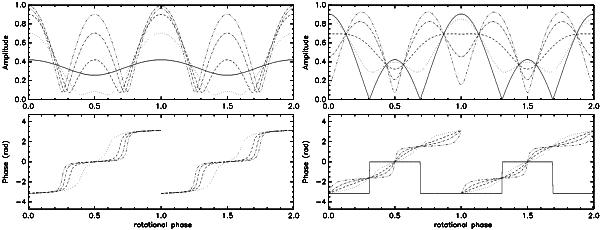Fig. 2

Shapes of the light curves influenced by different inclinations and polarizations of the dipole mode. In both panels, the inclination of the observer is i = 70°. (Left panel) We consider a given polarization of the mode ψ = 5°, and compute curves for various inclinations of the mode plane: γ = 5° (—), 25° (···), 45° (− − −), 65° (−·−), 85° (−···−). It is clear that for all inclinations but one (γ = 5°), the phase jumps π radians exactly at the amplitude minima since the modes show the two hemispheres during the rotation period (i.e., this verifies the conditions given in Eq. (A.2)). The position of the minima at Φm are shifted by a change in the inclination of the mode, as one can check in Eq. (25). (Right panel) Shapes of the light curves influenced by different polarizations of the dipole mode. We consider a given inclination of the mode γ = 45°, and compute curves for various polarizations ψ of the dipole axis: ψ = 0° (—), 20° (···), 40° (− − −), 60° (−·−), 80° (−···−). In both panels, we have represented two periods of rotation.
Current usage metrics show cumulative count of Article Views (full-text article views including HTML views, PDF and ePub downloads, according to the available data) and Abstracts Views on Vision4Press platform.
Data correspond to usage on the plateform after 2015. The current usage metrics is available 48-96 hours after online publication and is updated daily on week days.
Initial download of the metrics may take a while.




